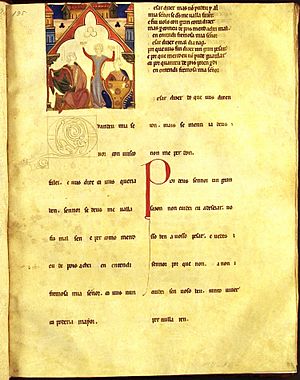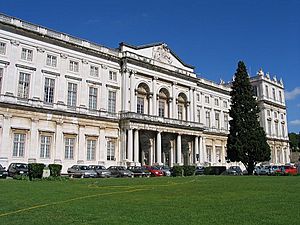Cancioneiro da Ajuda facts for kids
The Cancioneiro da Ajuda is a very old collection of poems from Portugal and Galicia. It was probably written in the late 1200s. This book is special because it's the oldest collection of these types of poems that were not religious. It also had spaces for music, but the music was never written down.
What is the Cancioneiro da Ajuda?
The Cancioneiro da Ajuda is kept in the library of the Ajuda National Palace in Lisbon, Portugal. It's a type of old book called a codex, made from parchment (animal skin). The text was written in an old style called Gothic script. Three different people worked on writing it.
The book also has beautiful, tiny drawings called miniatures. However, both the writing and the drawings were never fully finished. There were even spaces left for music notes, but they were never added.
This old book contains 310 poems. Most of them are called cantigas de amor, which means "love songs" sung by a man. Some poems are funny or satirical, and a few are conversations between a man and a woman.
History of the Cancioneiro
The first simple version of the Cancioneiro da Ajuda was printed in 1823. Later, a very important and detailed version was published in 1904. This was done by a German scholar named Carolina Michaëlis de Vasconcellos. Her work is still used by people who study these old poems today.
Another important copy of the text was made in 1941 by an American scholar, Henry H. Carter.
See also
 In Spanish: Cancionero de Ajuda para niños
In Spanish: Cancionero de Ajuda para niños



